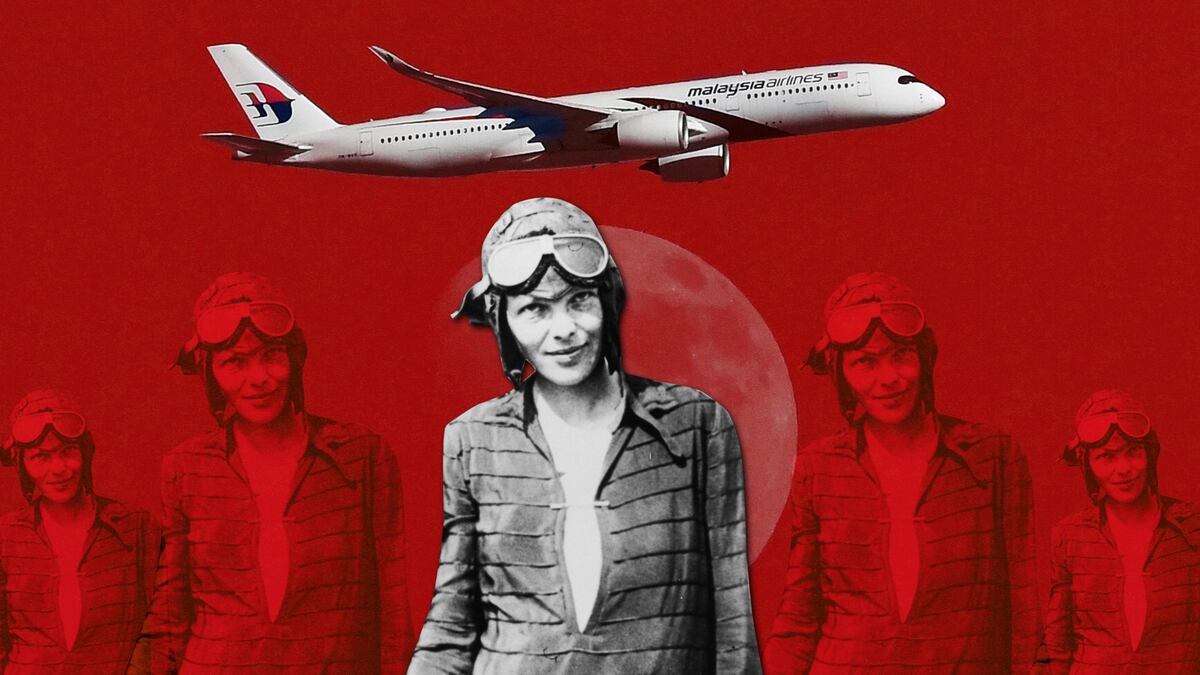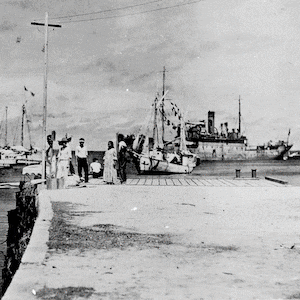The last time that Amelia Earhart’s voice was heard was at 8.43 a.m. local time over a remote corner of the Pacific Ocean on July 2, 1937.
She was flying a twin-engined Lockheed Electra, one of the sleekest of the new generation of airliners that normally flew medium distances between cities, but in this case was attempting a record-setting circumnavigation of the world.
In place of the passenger seats on Earhart’s Electra there were six large gas tanks, added to the regular gas tanks in the wings, and 80 gallons of oil to keep its supercharged engines running. Earhart piloted what was virtually a flying gas station.
Earhart and her navigator, Fred Noonan, had taken off from Lae, New Guinea, with enough fuel to give the airplane a maximum range of 4,500 miles, or 20 hours of flying time.
Their destination was Howland Island, a tiny blob in the middle of the Pacific, where a landing strip had been prepared for them. A U.S. Coastguard cutter was positioned near Howland and it was this that picked up Earhart’s last radio message. Because of a problem with the Electra’s radio the cutter’s radio operator could receive her messages but she could not receive their replies.
The airplane had been fitted with the latest navigation aids but Noonan’s navigation skills were suspect. He is thought to have been sending out distress signals for at least three hours after the cutter logged the last contact. By then Earhart was running low on fuel.
Since the Electra never found Howland Island, Earhart’s options were limited—either find another island on which a landing was possible, or ditch in the ocean.
Nobody knows how that turned out. Earhart and Noonan vanished without trace.
Malaysia Airlines Flight MH370 took off from Kuala Lumpur at 12.42 a.m. local time on March 8, 2014, with 239 people on board. Some seven hours and 30 minutes later the Boeing 777 disappeared in a remote stretch of the southern Indian Ocean as dawn was breaking.
No messages were sent from it during the last hours of the flight. It appeared to be flying normally at cruise height and speed until, having run out of fuel, it began a long, swooping dive and finally hit the ocean at a fearsome speed of 284 mph. One dipped wing struck the water first and the airplane was torn apart. The critical black boxes—flight data recorder and cockpit voice recorder—sank into the deep inside the fuselage while parts of the wing and tail sections floated as debris on the surface and, months later, turned up on beaches in the western Indian Ocean. The precise crash site remains unknown.
The latest of many searches for Earhart’s Electra has recently come up empty. Hopes were high this time because the search was led by the most renowned of the world’s undersea wreck hunters, Robert Ballard, the finder of the Titanic. He deployed the latest technology without finding a single clue.
In the last two decades there have been 14 expeditions to the middle of the Pacific looking for traces of Earhart’s Electra, and many millions of dollars have been spent on them.
In the case of Flight MH370 the last of two searches ended in June, 2018. This, too, deployed the most advanced deepwater search technology.
There are uncomfortable questions to be asked about these two mysteries of the deep.
For example, one involves a woman who achieved, along with Charles Lindbergh, an altogether new level of world celebrity based on the challenges of early aviation and, particularly, on the fearful risks posed by flying oceans. The other involves 239 souls whose names are unknown except to their kin.
What should the relative priorities be?
Finding traces of Earhart’s Electra won’t solve any technological issues; she and Noonan risked their lives with navigational aids that were, by today’s standards, really primitive. The everyday crossing of oceans safely by thousands of flights was then a very far-off dream.
The need to find the wreck of Flight MH370 is different.
It’s not just about putting a cold fiscal value on each of the 239 lives lost. That’s the grim calculation left to corporate and personal lawyers that usually takes years to resolve.
No, the continuing and urgent point is that today’s international air safety regime does not normally admit the possibility of an inexplicable disappearance of a state-of-the-art jet. In the absence of a wreck, conspiracy theories abound, while the real issue that must be pursued is—did something happen to this flight that could happen again?
The whole reason why flying has become progressively so much safer is that every accident, minor and major, is relentlessly interrogated until its causes are understood—and then rectified. This has become one of the most impressive and vital learning curves in the history of science—complicated by the fact that air disasters are frequently not just about science, they are a complex combination of human and scientific factors.
Sometimes the causes originate in a decision chain that leads back into the dark recesses of a company’s leadership, as they have with two crashes that caused the grounding of the Boeing 737-MAX.
Boeing is a party in this case, too, along with the airline and Malaysian officials. You would think they all have as much of an interest in solving the case as the families whose loved ones lost their lives. But they are all silent on whether it is worth continuing the search for a wreck that could still contain the answers.
The final search for MH370, lasting 90 days, was made by Texas-based Ocean Infinity using a swarm of eight autonomous drones, directed from a mother ship—far more advanced equipment than was used for the first 27-month search that immediately followed the airplane’s disappearance.
The drones were guided by three dimensional mapping, allowing them to closely scour challenging sea bed terrain sometimes as deep as 18,000 feet. The company self-funded the operation on a “no find no fee” contract with Malaysian authorities.
And it’s significant that since that failed search Ocean Infinity has made three different and spectacularly successful underwater searches.
In 2018 they found the wreck of an Argentine Navy submarine that was lost, together with a crew of 44, in 2017. In February this year they found the wreck of a South Korean ore carrier that sank off the coast of South Africa in 2017 with the loss of 22 crew. And in July this year they found the wreck of a French submarine that had been missing in the Mediterranean since 1968 with a crew of 52.
None of these wrecks was at the same depth as the area searched for MH370. The deepest was the ore carrier at around 10,000 feet.
But these successes were proof that the drone swarm technology can be very effective if there is reliable information indicating with some confidence the right area to be searched.
All along that has been the overhanging question about the search for the Malaysian jet. An airplane wreck is far harder to find than a ship or a submarine. For example, a Boeing 777 can fly 150 miles in 15 minutes. The jet was not being tracked in real time and so the calculations on its final position were very imprecise: The area first targeted was vast—more than 112,000 square kilometers.
On their search Ocean Infinity covered nearly as large an area in just 90 days. The odds are that that the wreck is somewhere in this remote area of the southern Indian Ocean.
In the case of the Earhart searches it seems doubtful that they have been looking in the right place, a conclusion that Ballard’s failure reinforces, since he was using equipment similar to that of Ocean Infinity.
All the recent searches share an assumption that Earhart, having missed Howland Island, made an attempt to land on Nikumaroro, an uninhabited atoll 350 miles southeast of Howland. The theory rests on the idea that at low tide there is a slender sandbar on which Earhart could have landed, and that her arrival would have coincided with low tide.
Landing on an aircraft carrier would be easier. A skilled pilot under stress, running low on fuel and trying to get a fix on a strip barely above sea level would be severely challenged and Earhart, despite her fame and courage, was not a flying ace. She had crashed the Electra during what should have been a routine test flight in Hawaii.
The outfit promoting this theory and behind many of the searches is the International Group for Historic Aircraft Recovery, TIGHAR. Richard Gillespie, the founder of TIGHAR, remains undaunted by the latest failure: “This is where it happened, this is where it ended up” he told the New York Times.
I suggest that before anybody else heads for Nikumaroro they do a relatively simple thing: program an off-the-shelf flight simulator with the known details of Earhart’s Electra—its weight, its approach speed, its handling characteristics, the wind speed—and see if they can get the airplane down on that sandbar at the first attempt (she probably would not have had enough gas to make a second).
There was also the debacle of a History Channel documentary made in 2017 that seriously advanced another theory: that Earhart and Noonan made a successful landing on another island, were captured by the Japanese, imprisoned as suspected spies and then secretly executed.
As I reported in The Daily Beast, this theory collapsed when it turned out that a single photograph on which the whole documentary rested, that two Westerners spotted on a dock on a Japanese possession, Kapingamaranji Island, were Earhart and Noonan, had actually been taken two years earlier, in 1935, as part of a travelogue.
Despite all these setbacks the Earhart search industry will, without doubt, continue as long as it can find the funds. The Pacific is a huge ocean and there are other atolls to pursue. As long as the aura of her celebrity and pull of the mystery persist there is a dramatic narrative to be imagined, if not actually confirmed.
There is no such glamorous compulsion or, apparently, any lingering curiosity about the fate of the 239 the people who boarded Flight MH370 that evening in Kuala Lumpur. It has become a cold case and the will to reopen it seems absent.
This is extraordinary because Ocean Infinity’s recent successes have vastly advanced search technology. In 2009, when Air France Flight 447 disappeared over the Atlantic, it took two years to find the wreck. At one point a French submarine using sonar scanning passed right over the wreck without seeing it. That would never happen now.
As for the cost of a new search, consider this: The money so far spent on the two searches for MH370 is around $200 million. That’s around half of what it costs to buy a new Boeing 777. The 239 victims of this calamity should not be forever lost—or forgotten.








